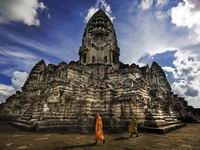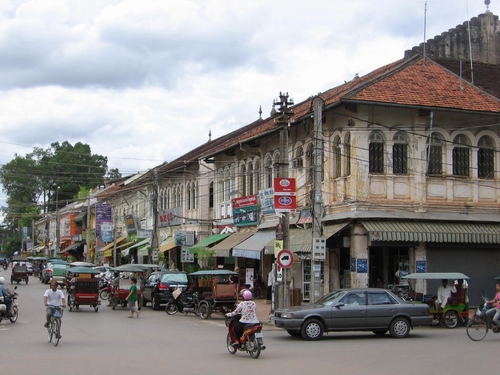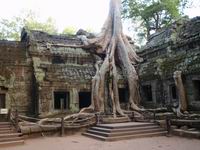|
Siem Riep -
AngkorWat
 The
historic ruins of Angkor are among the most incredible sites in the
world. There are few places if any that can match what remains of the
splendid Khmer civilization, which reached its flamboyant zenith between
the 9th and 14th centuries. The top draw, the Angkor Wat, is deservedly
one of the Seven Wonders of the World. The
historic ruins of Angkor are among the most incredible sites in the
world. There are few places if any that can match what remains of the
splendid Khmer civilization, which reached its flamboyant zenith between
the 9th and 14th centuries. The top draw, the Angkor Wat, is deservedly
one of the Seven Wonders of the World.
Siem Reap is the small but rapidly expanding town that serves as the
base for the temples which are set in protected jungle 8km away. Angkor
itself is a fantastic and magical place. The varying character,
isolation and romance of the sites leave a strong and lasting impression
- it is definitely worth the trip.

The lost city of
Angkor
Angkor has many temples spread over a large area which could easily
take up a week. Its better to spend a few leisurely days taking it
in slowly and to avoid the standard tourist circuits - temples have
rather predictable peak times. Tours are highly recommended if
pushed for time. Absolutely essential are The Angkor Wat, The Bayon
and Ta Prohm. Take plenty of camera film - the scenery is
breathtaking.
The chief attraction is the magnificent Angkor Wat. This stunning
temple complex is the largest religious structure in the world and
up there with the Great Wall and the Pyramids. Its a staggering and
unique architectural achievement. A giant causeway leads to
exquisite bass reliefs, courtyards and majestic towers. The temple
is a joy to explore and can even be clambered to its loftier levels.
Easily the most impressive site in Southeast Asia.
The second attraction is the small city of Angkor Thom, the
highlight being the enigmatic Bayon. Giant carved faces smile
contently at visitors exploring the nooks and crannies of this
jumbled structure. Several lesser and collapsed ruins dotted within
Angkor Thom could be missed if pushed for time. The gates to the
city are worth a snap. The Bayon has perhaps the most character of
any temple in Angkor - say goodbye to another roll of film.
Often top of the favourites list is the surreal Ta Prohm. Ta Prohm
has been left pretty much as it has been for centuries - overgrown
and tangled in roots. The jungle has enveloped the lost ruins. The
result could be considered a work of art. Add to that the symphony
of the jungle it wouldnt take much imagination to picture Indiana
Jones popping up. Fantastic, cannot be missed.
Bantay Srei is one of the more remote temples further out and a
little different to the grey stone temples around Angkor City. This
small and well-preserved sandstone Hindu temple is a fiery copper
colour featuring exquisite bas-relief carvings. The fine workmanship
and condition of these carvings is striking. Well worth seeing and a
contrast to the others.
All tours seem to include sunset at Phnom Bakheng, a small temple
atop a steep hill. To be honest, this is Angkor tourism at its worst
- everybody converges here at sunset and the air is thick with
frantic cries from vendors. The view makes a good photo if you can
exclude the crowds, but its certainly not a serene place. The temple
itself is modest by Angkor standards, the novelty being the pricey
elephant rides up to the top. If you dont mind the rush hour crowds
its fine - if you do, forget it.
Another collapsing and tree-gripped temple is Preah Khan. This
larger temple features some of the romantic disrepair of Ta Promh
but is larger and in the open. Its size makes it easy to disappear
down lonely corridors and emerge into deserted courtyards. Bold,
imposing and quieter than some of the others.
Ta Keo is a historic construction site - it was never finished after
a lightning strike was deemed a bad omen. The steep steps and towers
are there but the sandstone was barely worked. Its pretty stark and
rather average close up.
The brick Eastern Mebon is another that may be glimpsed from a
passing car. This one warrants a mention as close up the bricks are
full of drilled holes and the two well-preserved stone elephants are
rare features. The carved towers are in good shape. OK for a wander.
Ta Som is a quiet smaller version of overgrown and collapsing Ta
Promh with a few faces of the Bayon beaming out. Often overlooked,
its a good little spot that seems to have a bit of everything.
The Rulos group are ruins scattered 24km east of Siem Reap amongst
local villages. The earliest surviving temples are made of crumbling
brick and sandstone and are in varying states of repair. Less
impressive and less visited but with a certain charm.
There are many other temples dotted about that are similar to those
above but with lesser scale, atmosphere, craftsmanship or
preservation. It can be very rewarding to visit them as you have the
chance of having an ancient ruin all to yourself, at least for a
while.
Note: Watch your footing! Its surely just a matter of time before
someone plunges to their doom from the almost vertical steps of the
upper tiers of the Angkor Wat. Also the uneven rugged blocks and
floors and protruding roots that feature around any temple trip many
a traveller. The heat and physical exertion required to clamber
around is tough on older visitors.
Other attractions
Siem Reap is modest with few attractions but its easy to get templed
out in Angkor and well worth breaking up the trip with a few
diversions.
A great and enlightening trip is the Vietnamese Floating Village.
Crowded on the shores of the highly fertile Tonle Sap Lake, the
traditional fishing community is an interesting spot full of
character that makes for some good photos.
The Department of Defense has opened a War Museum with plenty of
military hardware on display. For a reminder on how Cambodia has
been ravaged by war, worth a visit.
Run by the Cambodian foundation for deprived children, the
Exhibition on Tonle Sap is a well presented extract on the lake and
how it supports the community. It outlines some of the success
stories the foundation has had with child welfare and how much more
there is to do. On the road to the temples and worth a short stop.
The Tonle Sap Lake includes several UNESCO biosphere reserves that
protect the superb biodiversity of the area. Bird watchers in
particular are in for a treat.
In the centre of town is the unusual Butterfly Garden. Worth a quiet
drink just to enjoy the 1000 or so butterflies.
There's a low-key Crocodile Farm on the edge of town that also has a
few lizards and monkeys. Crocodile products are available at this
passable pit-stop.
Tourist Information Offices
There is a token tourist office opposite the Grand Hotel D'Angkor -
slack and not particularly helpful. Hotels and restaurants have
plenty of useful stuff including the free Angkor Guide which gives a
thorough breakdown of the area.
Entertainment and Eating Out
There's not a huge choice of entertainment in town. The restaurant
scene is better but still broadly budget.
Most larger hotels put on cultural shows featuring traditional
dancing. The Grand Hotel D'Angkor has perhaps the best show taking
place with a buffet on the lawns outside the hotel most evenings.
The Royal Angkor Sofitel Hotels inviting pool can be used by
non-guests for a steep fee. Even during peak season its a quiet and
relaxing spot. The stadium close by stages intermittent and varying
local entertainment. Thai boxing is a popular feature.
The children from Krousar Thmeys Orphanage put on a shadow puppet
play every Thursday at La Noria Restaurant - every cent goes to help
disadvantaged Cambodian children.
Massage is widely available in Siem Reap, its usually very obvious
to tell the legitimate establishments from the ones providing extra
services. A good one is Angkor Massage on Airport Rd where you can
be kneaded by the blind.
There aren't many top restaurants in Siem Reap. The finest dining is
offered by the top hotels - some superb dishes are available at the
sophisticated Grand Hotel D'Angkor and Sofitel restaurants.
Restaurant food outside is average on the whole although the open
atmosphere and prices are very attractive. There are a few good
places worth sampling, probably the best being the FCC Siem Reap,
sister to the successful restaurant in Phnom Penh. Outlets around
the Old Market spring up and fall away so it's worth picking up a
copy of the 'Free Angkor Guide' to see what is new.
There are plenty of great pizza outlets in town - Happy Herb Pizza
is perhaps the best known but there's little between them. Difficult
to go wrong.
There are two Indian restaurants that serve up good, cheap and spicy
fare. Little India and New Delhi are behind the old market - Little
India is a little better. Sanctuary 36.5C is the sole Japanese
restaurant and bar.
A trendy joint offering a good international menu is The Red Piano.
Another popular western style one is Continental Caf offering a
broad but fairly expensive menu.
Definitely over-rated is the Bayon Restaurant which has slow service
and fairly bland dishes. Seems to have gone downhill with a few good
write-ups in the past guaranteeing its customers a good meal.
There are several clubs and discos in Siem Reap that offer the only
activity at night. Many double as pick-up joints for the nearby
brothels and dodgy massage parlours. Bakeng Night Club and Martini
are the most popular. Please be careful, AIDS is rampant in
 Cambodia, many of the taxi girls you'll see and their patrons are
HIV+. Cambodia, many of the taxi girls you'll see and their patrons are
HIV+.
There are several expatriate pubs drawing those far from home. Tooi
Tooi, The Angkor What?, The Blue Pumpkin and Liquid Bar are among
the better choices with live sports, pool tables and familiar menus.
|